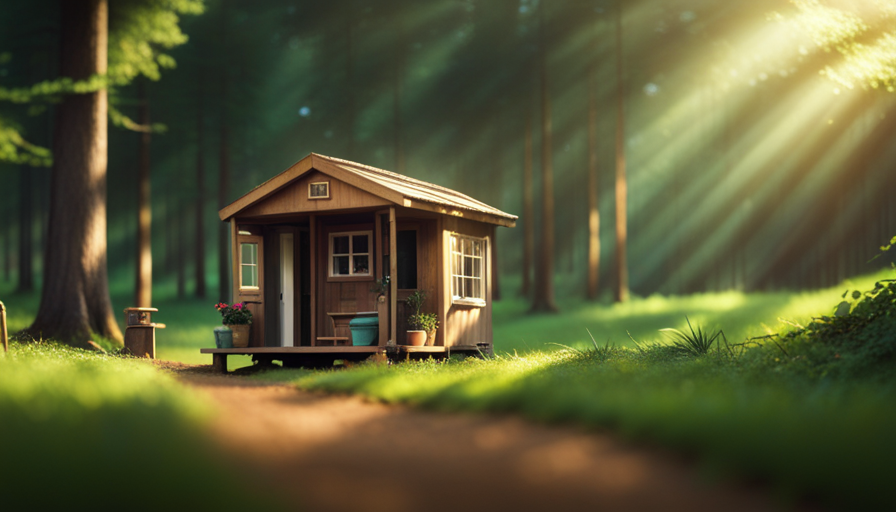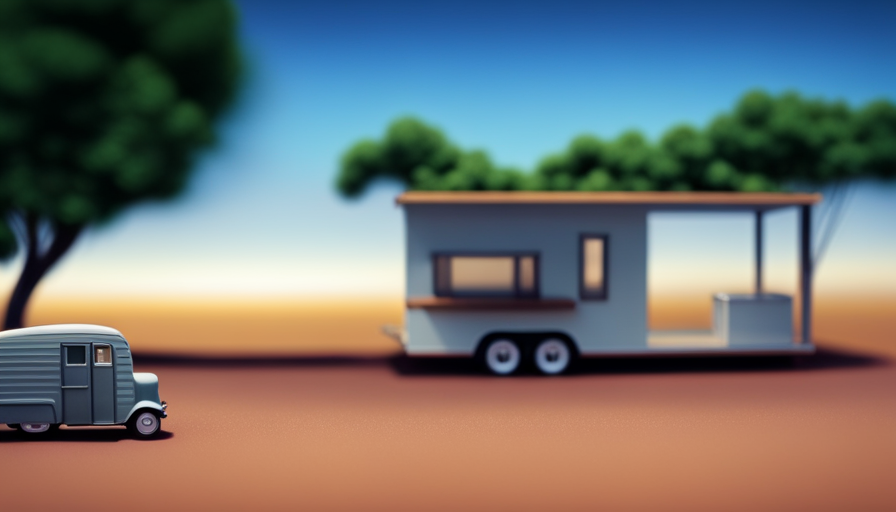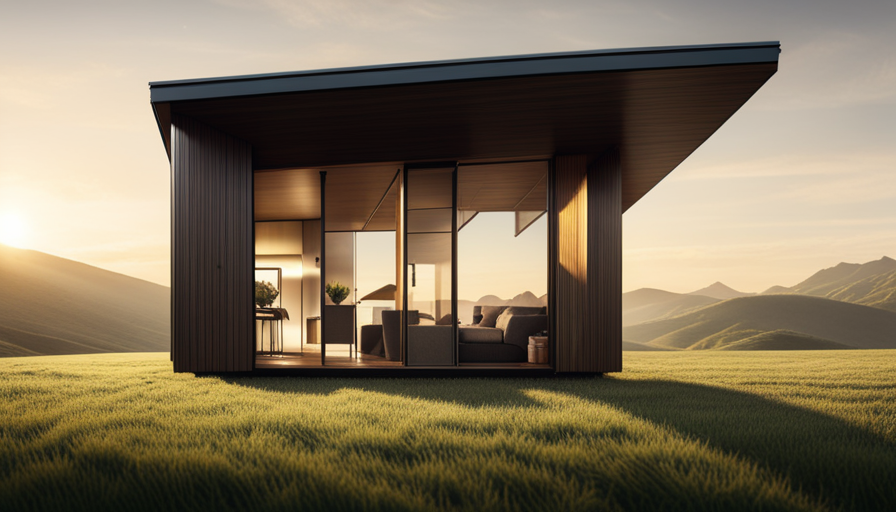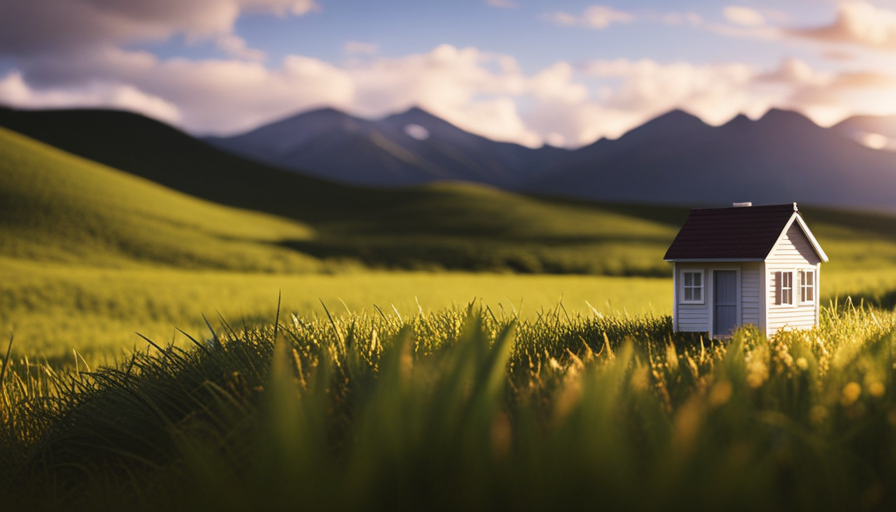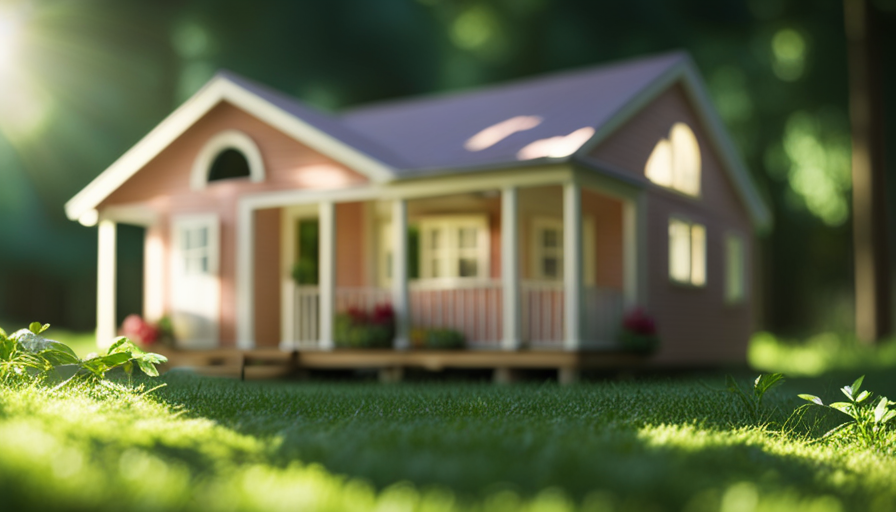Have you ever wondered how long someone can truly live in a small home? This question has caught my attention, and I have a feeling I’m not the only one.
Tiny house living has become a popular lifestyle choice in recent years, with people opting for simplicity, minimalism, and freedom from the burdens of traditional homeownership. But how long can one truly thrive in such a small space?
In this article, we will explore the appeal of tiny house living, the challenges that come with it, and the inspiring stories of those who have made it work. We will also share tips for making a tiny house feel like home, as well as delve into the world of building and designing your own tiny house.
Lastly, we will explore the sense of community that comes with joining the tiny house movement. So, if you’ve ever considered downsizing and embracing a simpler way of life, join me as we discover how long anyone can truly live in a tiny house.
Key Takeaways
- Tiny house living has become popular in recent years due to simplicity, minimalism, and freedom from traditional homeownership burdens.
- Living in a tiny house offers financial freedom and a simplified lifestyle.
- Three ways living in a tiny house can transform daily life include streamlined living, environmental consciousness, and a closer connection with nature.
- Tiny house dwellers have overcome obstacles and found happiness in their simplified lifestyle.
The Appeal of Tiny House Living
Imagine how liberating it would feel to live in a tiny house, where you can escape the burdens of excess and fully embrace a more minimalistic lifestyle.
Tiny house living has gained popularity in recent years due to its numerous benefits. One of the key advantages is the opportunity to practice minimalism, a philosophy that promotes living with only the essentials. By downsizing our possessions, we can focus on what truly matters, leading to a more fulfilling and intentional life.
Additionally, living in a tiny house has a positive environmental impact. These compact homes require fewer resources to build and maintain, resulting in reduced energy consumption and carbon emissions. Furthermore, tiny houses often utilize sustainable materials and technologies, such as solar panels and rainwater harvesting systems, further reducing their environmental footprint.
Transitioning into the subsequent section about the challenges of living in a tiny house, we must acknowledge that while the appeal of tiny house living is undeniable, it does come with its fair share of obstacles.
The Challenges of Living in a Tiny House
Living in a tiny house presents a unique set of challenges that require careful consideration. One of the biggest hurdles is the limited space and the need to find creative storage solutions. From utilizing vertical space to investing in multi-purpose furniture, it takes some ingenuity to maximize every square inch.
Additionally, there are zoning and legal issues to navigate, as not all areas are friendly to tiny houses. It’s important to research local regulations and obtain the necessary permits before setting up a tiny house.
Lastly, adjusting to a different lifestyle is a significant aspect of living in a tiny house. It requires a shift in mindset and a willingness to simplify one’s belongings and daily routines. Despite the challenges, many find the rewards of tiny house living well worth the effort.
Limited Space and Storage Solutions
With limited space and clever storage solutions, you’ll be amazed at how long you can comfortably reside in a tiny house. One of the biggest challenges of living in a tiny house is the limited space. However, with some creativity and smart storage solutions, you can make the most out of every inch.
From utilizing vertical space with shelves and hooks to investing in multi-functional furniture like foldable tables and hidden storage compartments, there are numerous ways to maximize storage in a tiny house. Additionally, you can minimize clutter by adopting a minimalist lifestyle and regularly decluttering your belongings.
By efficiently utilizing the limited space and implementing effective storage solutions, you’ll be able to live comfortably in a tiny house for a surprisingly long time.
Now, let’s move on to the next section about zoning and legal issues.
Zoning and Legal Issues
To fully understand the intricacies of zoning and legal issues surrounding your tiny home, you must familiarize yourself with the local regulations and building codes. Zoning regulations dictate where you can place your tiny house, whether it be on a permanent foundation or on wheels. Building codes ensure that your tiny home meets safety standards for electrical, plumbing, and structural components. Failure to comply with these regulations can result in fines or even the removal of your tiny home. It’s important to research and consult with local authorities to ensure that you are in compliance with all applicable regulations. By understanding and adhering to zoning and building codes, you can enjoy the benefits of living in a tiny house while avoiding potential legal issues.
Transitioning into the subsequent section about ‘adjusting to a different lifestyle,’ it is important to consider how living in a tiny house can change your daily routine and habits.
Adjusting to a Different Lifestyle
Transitioning into a smaller space, can you imagine how your daily routines and habits might change in a tiny home? Adjusting to minimalism and living off the grid requires a shift in mindset and lifestyle.
Here are three ways in which living in a tiny house can transform your daily life:
-
Streamlined Living: With limited space, you’ll need to declutter and prioritize what truly matters. This process of simplification can lead to a sense of freedom and clarity.
-
Environmental Consciousness: Living off the grid in a tiny house encourages sustainable practices such as using solar power, collecting rainwater, and composting. It offers an opportunity to reduce your carbon footprint and live a more eco-friendly life.
-
Connection with Nature: Tiny homes often embrace a close connection to the outdoors. Living in a smaller space can inspire you to spend more time outside, appreciating the beauty of nature.
As we explore inspiring stories of tiny house dwellers, their experiences shed light on the incredible possibilities of this lifestyle.
Inspiring Stories of Tiny House Dwellers
Living in a tiny house has allowed me to witness the incredible ways in which people have embraced innovative design and creatively used their limited space. From multi-functional furniture to clever storage solutions, these tiny house dwellers have truly mastered the art of maximizing every square inch.
Moreover, the unique customizations and personalizations that I’ve seen in tiny houses are truly inspiring. Each dwelling reflects the personality and preferences of its owner, making it a truly one-of-a-kind home.
Lastly, the stories of overcoming obstacles and finding happiness in tiny house living are nothing short of remarkable. From financial freedom to a simplified lifestyle, these individuals have discovered that less can truly be more.
Innovative Design and Creative Use of Space
With its clever use of foldable furniture and hidden storage compartments, the tiny house feels like a cozy and efficient living space.
Innovative storage solutions are key in maximizing the limited square footage, allowing for a clutter-free environment. From built-in shelving units to multi-functional pieces of furniture, every nook and cranny is utilized to its fullest potential.
Additionally, large windows and skylights are strategically placed to maximize natural light, creating an open and airy atmosphere. The combination of innovative storage and ample natural light gives the illusion of a larger space, making the tiny house feel more comfortable and inviting.
As we transition to the next section about unique customizations and personalization, it’s fascinating to explore how these homeowners have made their tiny houses truly their own, reflecting their individual style and preferences.
Unique Customizations and Personalization
The remarkable customizations and personal touches in these tiny homes truly make them one-of-a-kind, reflecting the unique style and preferences of their owners. From ingenious storage solutions to creative decor choices, the possibilities for customization in a tiny house are endless. Owners have come up with some truly unique ideas to make their tiny home feel like a reflection of themselves.
To illustrate some of these ideas, consider the following table:
| Customization Ideas | Personalized Decor Options | Creative Storage Solutions |
|---|---|---|
| Built-in bookshelves | Vintage artwork | Hidden compartments |
| Fold-down dining table | Handmade pottery | Under-bed storage |
| Lofted sleeping area | Eclectic tapestries | Wall-mounted organizers |
Each of these elements contributes to the overall aesthetic and functionality of the tiny home. It’s fascinating to see how individuals have personalized their tiny spaces to suit their needs and express their personality.
These unique customizations and personal touches not only make the tiny homes more functional but also contribute to the happiness and satisfaction of their owners. They have successfully overcome the challenges of living in a small space and have found joy in their personalized havens.
Overcoming Obstacles and Finding Happiness
When you face obstacles in your tiny home journey, finding happiness becomes even more rewarding. Living in a tiny house comes with its own set of challenges, but overcoming them can lead to a sense of accomplishment and contentment.
From limited storage space to adjusting to a smaller living area, there are various obstacles that one must navigate in a tiny house. However, by finding creative solutions and embracing a minimalist lifestyle, these challenges can be overcome.
It is important to focus on the positives of tiny house living, such as the financial freedom, environmental sustainability, and the opportunity to simplify your life. By doing so, you can find contentment in your tiny home and create a space that truly feels like home.
Transitioning into the subsequent section about tips for making a tiny house feel like home, it is essential to consider various design and organization strategies.
Tips for Making a Tiny House Feel Like Home
When it comes to making a tiny house feel like home, there are several key points to consider.
Clever space-saving solutions are essential in maximizing the limited square footage available.
Multi-functional furniture and storage ideas are also crucial in creating a functional living space.
Lastly, creating a cozy atmosphere is important for making a tiny house feel welcoming and comfortable.
By incorporating these elements, one can transform their tiny house into a truly livable space.
Clever Space-saving Solutions
Imagine living in a tiny house where every nook and cranny is cleverly designed to maximize space and make you feel like you’re living in a luxury mansion. Clever storage solutions are key in tiny houses, as they allow you to make the most of every square inch.
From utilizing vertical space with floor-to-ceiling shelves, to incorporating hidden compartments in furniture, there are endless possibilities. Think about under-bed storage, built-in cabinets, and fold-out tables that can be tucked away when not in use. These ingenious ideas not only help you stay organized, but also create a sense of openness and spaciousness in your tiny home.
As we move into the next section about multi-functional furniture and storage ideas, it’s important to consider how these solutions can further enhance your living experience without sacrificing style or comfort.
Multi-functional Furniture and Storage Ideas
To truly optimize your living space, it’s essential to explore the myriad of possibilities offered by multi-functional furniture and storage ideas. These innovative solutions not only save precious space but also add functionality and style to your tiny house. Take a look at the table below for some inspiring examples:
| Furniture/Storage Idea | Description | Benefits |
|---|---|---|
| Wall-mounted desk | A foldable desk that can be easily attached to the wall | Saves floor space, doubles as a workspace |
| Ottoman with hidden storage | An ottoman that opens up to reveal a spacious storage compartment | Provides extra seating and hides clutter |
| Loft bed with built-in wardrobe | A bed elevated above a built-in wardrobe | Maximizes vertical space, combines sleeping and storage areas |
These are just a few examples of the many multi-functional furniture and storage solutions available. By incorporating these ideas into your tiny house, you can create a cozy and functional living space that maximizes every inch. Transitioning into the next section, let’s explore how to create a cozy and functional living space in your tiny house.
Creating a Cozy and Functional Living Space
Now that we’ve explored the concept of multi-functional furniture and storage ideas, let’s dive into the next step of creating a cozy and functional living space in a tiny house. Designing a small living space requires careful consideration and creativity to maximize efficiency.
One key aspect is utilizing every inch of available space. From utilizing vertical wall space for storage to incorporating hidden compartments, there are numerous ways to make the most of a limited area.
Additionally, choosing furniture and decor that serve multiple purposes, such as a sofa that doubles as a bed or a coffee table with built-in storage, can further optimize the functionality of the space.
By carefully selecting and arranging each element, it’s possible to create a snug and inviting atmosphere in even the smallest of spaces.
Now, let’s explore the exciting process of building and designing your own tiny house.
Building and Designing Your Own Tiny House
Have you ever considered building and designing your very own tiny house? It may seem like a daunting task, but with the right building techniques and a little bit of planning, you can create a space that is both functional and energy efficient.
When it comes to building a tiny house, there are a few key techniques that can make a big difference. One of the most important considerations is maximizing space. This means utilizing every nook and cranny, from under the stairs to above the kitchen cabinets. Additionally, incorporating multipurpose furniture and built-in storage can help to optimize the limited square footage.
Another important aspect to consider when building a tiny house is energy efficiency. With a smaller space, it’s easier to heat and cool, but it’s still important to make sure that the house is well-insulated and properly sealed. This can help to reduce energy consumption and save money on utility bills. Additionally, using energy-efficient appliances and LED lighting can further minimize energy usage.
By incorporating these building techniques and focusing on energy efficiency, you can create a tiny house that is both functional and environmentally friendly. But building a tiny house is just the first step. In the next section, we’ll explore the benefits of joining the tiny house community and how it can enhance your experience of living in a small space.
Joining the Tiny House Community
Are you ready to become part of a supportive and thriving community that shares your passion for sustainable living and minimalist lifestyles? According to a recent survey, over 80% of tiny house owners report feeling a strong sense of belonging and connection within the tiny house community. Joining the tiny house community offers numerous benefits and resources for building and designing your own tiny house. Here are five reasons why becoming part of this community is a great decision:
-
Supportive Network: The tiny house community is filled with like-minded individuals who’re always ready to offer support and guidance throughout your tiny house journey.
-
Shared Knowledge: By joining the community, you gain access to a wealth of knowledge and expertise from experienced tiny house owners who can provide valuable insights and tips for building and designing your own tiny house.
-
Resource Sharing: Within the community, resources for building and designing are readily shared. From finding affordable building materials to learning about local zoning regulations, the community can help you navigate the challenges of tiny house living.
-
Workshops and Events: Many tiny house communities organize workshops and events where you can learn new skills, connect with others, and gain inspiration for your own tiny house project.
-
Sustainable Living Advocacy: By joining the tiny house community, you become part of a larger movement advocating for sustainable living and minimalist lifestyles, making a positive impact on the environment.
Joining the tiny house community provides a supportive network, shared knowledge, resource sharing, access to workshops and events, and an opportunity to advocate for sustainable living. Embrace the sense of belonging and connection that comes with being part of this thriving community.
Frequently Asked Questions
What is the average cost of living in a tiny house?
The average cost of living in a tiny house varies depending on factors such as location, size, and amenities. However, financing options are available to make it more affordable.
Tiny houses offer a cost-effective alternative to traditional homes, with lower utility bills and maintenance costs. Additionally, downsizing can lead to a simpler and more sustainable lifestyle.
Considering these factors, living in a tiny house can be a financially wise and environmentally friendly choice.
Are tiny houses legal in all states?
Tiny house regulations vary by state, so it’s important to research the specific laws in your area. While some states have embraced the tiny house movement and created regulations to accommodate them, others have stricter regulations or may not have specific guidelines at all.
However, there are tiny house communities popping up across the country that offer a supportive environment for those interested in living in a tiny house. These communities often have their own set of regulations and guidelines to ensure a cohesive and sustainable living environment.
Can you have a family with children living in a tiny house?
Yes, it’s possible to have a family with children living in a tiny house. However, family dynamics and space constraints should be carefully considered.
Living in a tiny house requires efficient use of space, creative storage solutions, and a minimalist lifestyle. It may be challenging to accommodate the needs and activities of a growing family within limited square footage.
Nonetheless, with careful planning and organization, families can create a cozy and functional living environment in a tiny house.
How do tiny house dwellers handle basic utilities such as water and electricity?
Tiny house dwellers handle basic utilities such as water and electricity by employing strategies for water conservation and embracing off-grid living.
Water is conserved through measures like low-flow fixtures, capturing rainwater, and using composting toilets.
Electricity is generated through solar panels or wind turbines, enabling a self-sufficient lifestyle.
By minimizing water usage and becoming independent from the grid, tiny house dwellers can live sustainably and reduce their environmental impact.
What are the zoning regulations for parking or placing a tiny house on a property?
Parking restrictions and building codes are important factors to consider when placing a tiny house on a property. Zoning regulations vary depending on the location, so it’s crucial to research and understand the specific rules in your area.
Local authorities may have restrictions on where you can park or place a tiny house, such as minimum setbacks from property lines or requirements for off-street parking.
Additionally, building codes may dictate the size, materials, and safety features of the tiny house to ensure compliance with structural and fire safety standards.
Conclusion
In conclusion, living in a tiny house is truly an adventure like no other. From the challenges of limited space to the inspiring stories of those who’ve embraced the lifestyle, it’s clear that tiny house living isn’t for the faint of heart. But for those who’re brave enough to take the plunge, the rewards are immense. With a little creativity and resourcefulness, a tiny house can truly become a cozy and comfortable home.
So go ahead, join the tiny house community and see where this miniature world takes you. It may just be the best decision you ever make.
Hi, I’m Emma. I’m the Editor in Chief of Tiny House 43, a blog all about tiny houses. While tree houses are often associated with childhood, they can be the perfect adult retreat. They offer a cozy space to relax and unwind, surrounded by nature. And since they’re typically built on stilts or raised platforms, they offer stunning views that traditional homes simply can’t match. If you’re looking for a unique and romantic getaway, a tree house tiny house might just be the perfect option.
